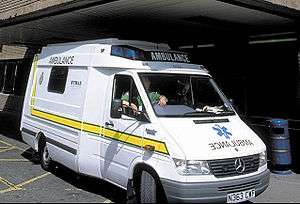West Yorkshire Metropolitan Ambulance Service
| West Yorkshire Metropolitan Ambulance Service | |
|---|---|
| WYMAS | |
|
NHS corporate identity logo for WYMAS | |
|
Non-NHS corporate identity logo for WYMAS | |
|
A WYMAS ambulance outside a hospital in Leeds | |
| Created | 1 April 1974 |
| Disbanded | 1 July 2006 |
| Headquarters | Birkenshaw and then Wakefield, England |
| Region served | County of West Yorkshire and the Craven area of North Yorkshire |
| Type | Defunct NHS Ambulance Service |
West Yorkshire Metropolitan Ambulance Service, or 'WYMAS', was the NHS ambulance service covering West Yorkshire and the western side of North Yorkshire. On 1 July 2006 it was merged to the single Yorkshire Ambulance Service.
History
West Yorkshire Metropolitan Ambulance Service was formed in 1974, bringing together the individual city services which existed across the county. In 1992, it became an NHS Trust, providing 24-hour emergency and healthcare services to more than 2.1 million people across the region.
Geography
WYMAS covered the whole of West Yorkshire, including the cities of Bradford, Leeds, and Wakefield, and the principal towns of Halifax, Huddersfield and Pontefract. In addition, WYMAS' coverage extended into the Craven area of North Yorkshire with ambulance stations at Grassington, Ingleton, Settle and Skipton, covering the western side of North Yorkshire and the Yorkshire Dales. The region included parts of the M1, A1(M), M62, M621 and M606 motorways, and West Yorkshire itself is highly industrial.
Neighbouring ambulance services covered Greater Manchester, Lancashire, North Yorkshire and South Yorkshire.
There were 21 ambulance stations situated across the WYMAS operating area.
Services
WYMAS activities were centred on two core activities: Accident & Emergency (A&E) and Patient Transport Services (PTS). Both covered areas far and wide, from the rural areas around Settle and Skipton in the North or the Holmfirth and Honley stations in the South; to the inner city suburbs of busy Leeds and Bradford, and were controlled from one of the most up to date Communication Centres in Europe, located at the Service's headquarters at Birkenshaw, south of Bradford.
Behind the scenes, WYMAS had an extensive network of services to provide vital support to those on the frontline - everything from finance, human resources and occupational health, to the domestic team and training department.


